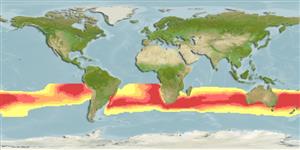Classification / Names
Common names from other countries
Main reference
Size / Weight / Age
Max length : 105 cm FL male/unsexed; (Ref. 5313); common length : 86.0 cm TL male/unsexed; (Ref. 9684); max. published weight: 13.7 kg (Ref. 5313)
Environment
Marine; pelagic-oceanic; oceanodromous (Ref. 51243); depth range 0 - 20 m (Ref. 86942)
Climate / Range
Subtropical, preferred ?; 10°S - 50°S, 180°W - 180°E (Ref. 168)
Distribution
Short description
Dorsal
spines
(total): 15 - 18;
Dorsal
soft rays
(total): 12-13;
Anal
spines: 0;
Anal
soft rays: 13 - 14;
Vertebrae: 40. Interpelvic process small and bifid. Body naked ventrally behind the long anterior corselet. Dorsal half of body to lateral line covered with scales. Swim bladder absent. The back is bluish, turning to deep purple or almost black on the head; the belly is white, without stripes or spots; the pectoral and pelvic fins purple, their inner sides black.
IUCN Red List Status (Ref. 115185)
Threat to humans
Harmless
Human uses
Fisheries: minor commercial
Tools
Special reports
Download XML
Internet sources
Estimates of some properties based on models
Phylogenetic diversity index
PD50 = 1.0000 many relatives (e.g. carps) 0.5 - 2.0 few relatives (e.g. lungfishes)
Trophic Level
3.7 ±0.1 se; Based on diet studies.
Resilience
Medium, minimum population doubling time 1.4 - 4.4 years (Preliminary K or Fecundity.)
Vulnerability
Moderate to high vulnerability (51 of 100)
Price category
